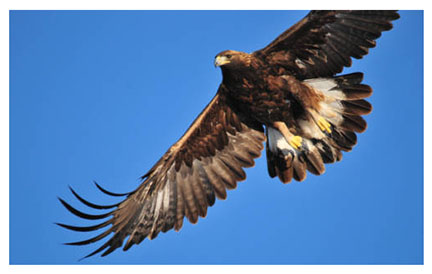


(Aquila chrysaetos)
A rare bird of remote mountains, tundra, grasslands, and deserts; it ranges over a large part of the Northern Hemisphere. This bird of prey has a wingspread of well over six feet, with females even larger than the males, which is general among birds of prey. Both adults and immatures have the rich dark brown body plumage. The golden neck feathers are seen only at close range. The broad white tail band and white wing patches of the immature are good field marks. Note its buteo flight with very long rounded wings. Legs are feathered to the toes. The call is a set of rapid sharp chips.
The Golden Eagle feeds mostly on rodents (rabbits and ground squirrels) but has also been known to attack small lambs and turkeys. Like most eagles it also eats carrion and will feed on dead lambs. This practice has caused farmers to suspect that the eagle actually killed the lamb, which it is capable of doing but rarely does so. Eagles sometimes resort to hunting in pairs. The Golden Eagle does not have at least one complete annual molt; instead the molt takes two years.
The birds mate for life. They build a nest of sticks in a high inaccessible spot, either on a ledge or a tree. The nest site, or eyrie, is often reused over many years. A clutch of two eggs is the norm. The eggs are dull white flecked and spotted with red brown and grey. There is usually a three-day interval between the laying of each egg. Incubation begins with the laying of the first egg, which means there is a staggered hatch producing two chicks differing slightly in size and strength. The larger, stronger chick many times attacks the younger, weaker one, which often dies from such persecution and lack of food. The remaining eaglet leaves the nest after about nine or ten weeks but stays with its parents for some time afterward, learning the hunting skills it needs for its survival. It takes five years for the bird to become a mature breeding bird.
Class: Aves | Order: Accipitriformes | Family: Accipitridae | Genus: Aquila | Species: A. chrysaetos
photo courtesy US Fish & Wildlife Service - Tom Koerner





